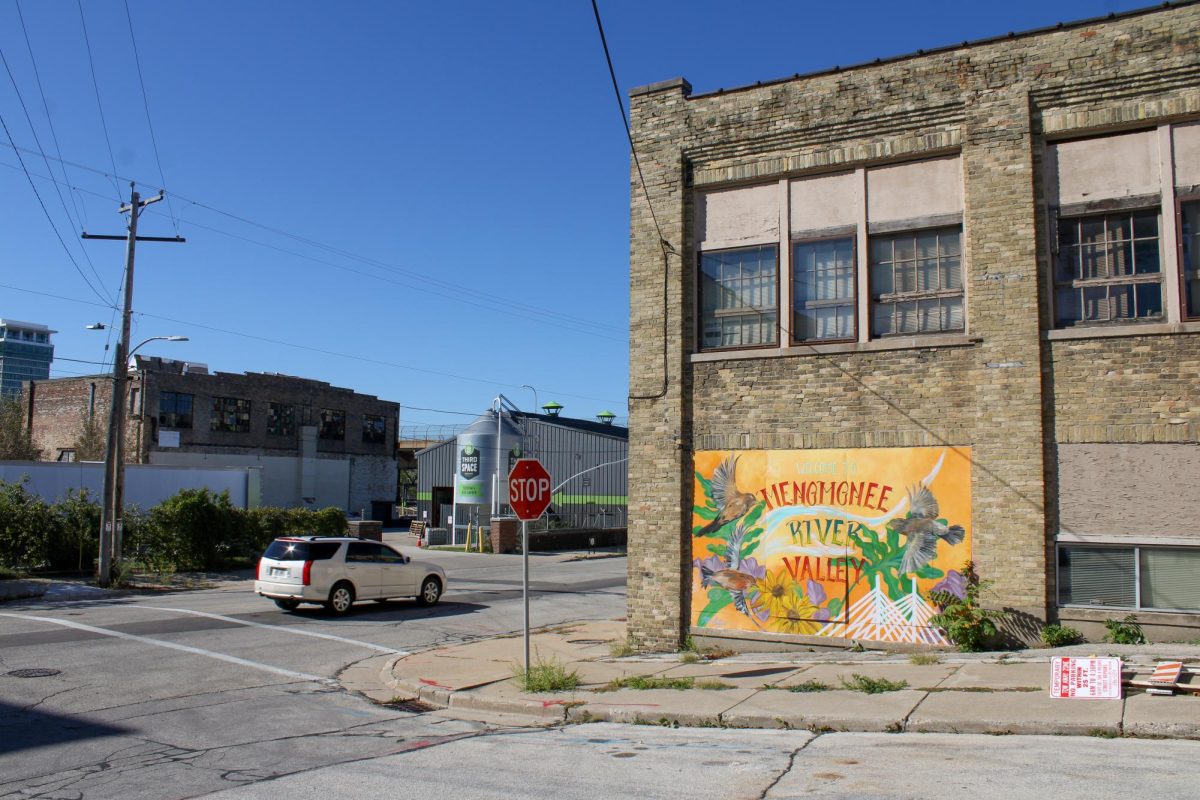This story was written in December of 2024
It’s easy for Milwaukee residents to drive over the Menomonee Valley. Rusted and towering viaducts make the commute across this sunken area of the city a breeze. While the valley has its attractions, including the famous Harley Davidson Museum, American Family Field and Potawatomi Casino Hotel, the valley is otherwise sullen and lifeless.
Contributing to the eerie atmosphere of this neighborhood is a building at 324 N 15th St., tattered and tagged, with countless broken windows on each of its four stories. Built in 1890, this building was formerly the site of Geuder, Paeschke & Frey, a tinware and enamel company. Since 1984, it has stood vacant in Milwaukee’s Menomonee Valley.
Kendall Breunig, a developer with Sunset Investors LLC, a real estate company, plans to retrofit this long-abandoned building on 15th Street and St. Paul Avenue. He hopes to create around 45 apartments inside and a parking garage on the grass lot adjacent to the building. With Marquette’s campus just a few blocks away, he thinks the building would be a great spot for students.
However, not everyone was on board. Breunig needed a zoning change in order to turn the building into apartments. The Department of City Development, as well as Menomonee Valley Partners, an organization devoted to bringing together the neighborhood’s businesses and shareholders, both pushed back against Breunig’s request.
“It often conflicts when you have residential and industrial together,” Nia Smith, MVP’s project manager, said. “But MVP is really like a convener, so we’re looking with all of our stakeholders to find a path that is acceptable.”
Smith said the lack of amenities that a typical residential neighborhood would have make it hard for people to start living in the Valley. In addition to this, residents are not a main priority of MVP or the Valley in general.
“It’s really important to us to preserve urban industrial land in the Valley,” Smith said. “Part of the Valley is to create family supporting jobs.”
Recently though, things began to move forward. After it looked like the city’s opposition to the zoning change was set in stone, Breunig finally got his wish. On November 19, his proposal was presented in a Zoning & Neighborhood Development Committee hearing where it passed. The following week on November 26, the zoning change was presented to the Milwaukee Common Council where it was approved by a vote of 13-1. Now, Breunig plans to finalize his purchase of the building before the end of the year.
The Valley has long stood as Milwaukee’s industrial corridor. Nicknamed the “Machine Shop of the World,” the Valley employed some 50,000 residents in the 1920s. Though it wasn’t long before industry practices changed, companies abandoned their factories and warehouses, and the Valley was left to rot. According to John Gurda, a historian who has spent his career writing on Milwaukee’s history, the Valley was an “armpit” before the turn of the century.
“It was filthy and unvisited,” Gurda said. “The turnaround there is amazing.”
Breunig envisions the future of the valley differently, a place where residents can live alongside its industry.
“They want to keep the industrial part of the industrial district,” Breunig said. “The problem is this building can no longer function as industrial, and it can’t even function as offices.”
According to Breunig, a structural analysis of the building determined that it would not be able to support the weight associated with industrial or office use. To him, the only way forward is with residents. Breunig says that St. Paul Avenue, where the building is located, is a “commercial corridor” more than it is industrial. He thinks this building would fit right in with the “different feel” this part of the Valley has, compared to the more industrial areas to the south.
On St. Paul Avenue, just four blocks west of Breunig’s proposed apartment building, sits Sobelman’s Pub and Grill. Owner Dave Sobelman likes the idea of residents close to his businesses and said he would even consider moving in.
“We have this big house, we just don’t need it,” Sobelman said. “Purchasing one and being four blocks away from my business, that would be great.”
A towering cream brick building that once operated as a former saloon for Valley brewery workers, Sobelman’s is known for their bloody marys and burgers. Sobelman can be seen there on most days, greeting patrons as they walk into the dimly lit restaurant. Though Sobelman says weekdays aren’t as busy as he would like.
“I don’t really have a neighborhood like that, there’s no residences down here,” said Sobelman. “Which goes back to one of the reasons I would like to see that apartment building become residential.”
Sobelman talked about driving past other restaurants bustling with business during the evening, while on the way to his own where only a few tables would be in use.
“Occasionally, I’m jealous of those restaurants that are in a community where they might not have the lunch business I have, but they’ve got the dinner business,” Sobelman said, “because people leave the Valley, and they head home.”
Now, Smith of MVP says Breunig’s plan is the “best hope” in preserving this landmark building. She said a compromise was made that prioritizes the success of existing Valley businesses.
“This building is super unique,” Smith said. “It’s the only building in the Valley that has been locally designated as historic, and it’s been abandoned for 40 years.”
Breunig has agreed to continue in his search for commercial tenants, though MVP is aware of the large financial cost this would bring upon any such businesses due to the restructuring required. He says this zoning change approval is just one hump he’s over, with many more to come. He still plans to provide a commercial space on the first floor of the building, but there are still circumstances that may hinder this.
“Even if I put a restaurant in there, I will have to get a zoning appeal or Board of Zoning Appeals approval for that also,” Breunig said, “because the zoning allows for restaurants, providing they’re on the arterial street.”
Currently, Breunig’s proposal would only have room for a restaurant on the south side of the building away from St. Paul Avenue.
Another part of the compromise between Breunig and MVP was that a disclaimer be present in the leases of the building. The disclaimer lets potential residents know that they are living in what Breunig described as an “Industrial Park,” where noise, traffic and other disturbances may be present.
While residents are still a long way from living in the building, the zoning approval is a massive step forward in solving a collective problem in the Valley.
“I think they’re happy to find a compromise and to continue to look for a situation that works for everyone,” Smith said. “This was a nuisance property, we always agreed this was a nuisance property for a lot of people. I think we’re just looking forward to having that issue eliminated.”
This story was written by Jack Belmont and Sofía Cortés. They can be reached at john.belmont@marquette.edu and sofia.cortes@marquette.edu.






